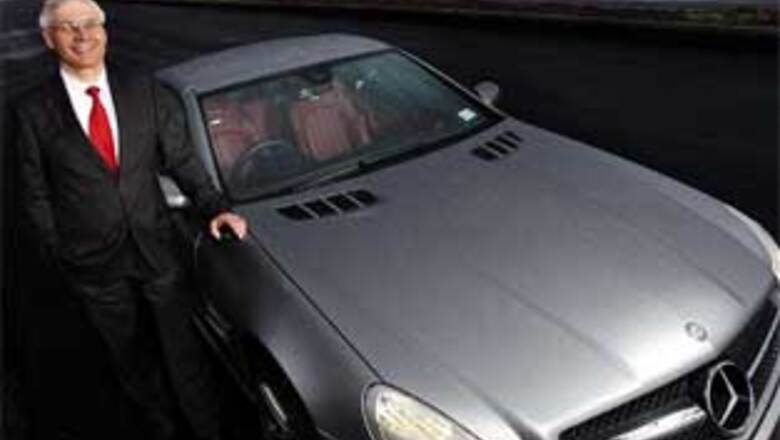
views
How long does it take for a BMW to overtake a Mercedes on Indian roads? Not that long, going by its current acceleration. One-and-a-half years back, the BMW was not even visible in the rear-view mirror of the Mercedes Benz. Now, it has left its fellow German rival spluttering in the slow lane.
BMW zoomed past Mercedes for the first time in India in January 2009 with sales of 270 cars compared to the Merc’s paltry 79. And it has steadily moved ahead, holding on to the top spot selling a total of 2,008 cars until July compared to Mercedes’ 1,606.
The fight between these two German giants in the Indian context is an interesting one. Mercedes is a silent, soft spoken car that immediately conjures up images of old money. BMW, on the other hand, is flashy and makes you sit up and take notice. Right now, it looks like young India likes to rev things up.
However, CEO of Mercedes-Benz, India, Dr Wilfried Aulbur, is not too worried. A stickler for time, he gets straight to the point, "We are in a situation, where in the E class segment we are looking at a run out of the old model. We have a limited number of old E classes to sell."
Mercedes hasn’t launched any product since it decided to phase out the old E class. India has not yet fully recovered from the economic slowdown; it was even less so in January 2009 when companies had frozen recruitments and cut salaries across the board. Mercedes could have been forgiven for thinking that this was going to be a slow year. Who would buy a luxury car when jobs were not certain?
Merc officials were content to coast along on the back of their 15-year old near-monopoly in the Indian market.
Enter BMW and Peter Kronschnabl. The President of BMW India has craftily built the company’s business in the country in just one-and-a-half years. People who have worked with him claim that ‘BMW’s success in such a short span has a lot to do with Kronschnabl’s eye for detail, aggression and risk taking ability.’
While the lack of a product in a major growing segment slowed down Mercedes, BMW swerved into this opportunity. The company recognised this handicap in Mercedes’ product portfolio quite early in 2008 and has since turbo-charged the sales of its 5 and 6 Series models; a strategy that has worked wonders for BMW.
Mercedes’ sales also suffered because of the lack luster performance of its new M class sports utility vehicle (SUV) which was launched in March this year. The new M class SUV was supposed to snatch back market share but it has failed to generate big volumes. In comparison, BMW’s SUV offerings, the X3 and the X5, have clocked good numbers.
"In the SUV segment, we are not satisfied with the number of sales we are seeing currently," says Aulbur.
Mercedes got stuck with two important product offerings, the E class and the M class, compared to BMW’s six product offerings in India. Experts believe that it has been BMW’s aggressive product strategy which has paid off.
"The number of models and variants that BMW brought in, with more in the pipeline this year, is working for them," says a senior auto consultant who didn’t want to be named.
Another reason for the shift in leadership is that BMW brings something new to the table. "BMW brings in a fresher look and brand experience and has more appeal amongst the younger set while Mercedes is associated more with the old customer segment; a CEO or an industrialist," says the consultant.
Aulbur is quick to disagree. "We are leading in the C class segment - it is the segment of the young person coming into the world of luxury. We are ahead of the BMW 3 series, ahead of the Audi A4 and are quite excited about that," he says.

PAGE_BREAK
The fight is just getting started. "Neither one is going to quit. While BMW has aggressive plans, Mercedes has a comeback strategy," adds the consultant. Mercedes’ new E class has sold 40,000 units globally since its launch this year.
Aulbur is looking to replicate its success in India. He says, "The new E class will be launched in India latest by December this year and is sure that it will gel with the Indian audience."
Behind the scenes, Mercedes is working feverishly on its network expansion strategy. The company has allocated an investment of close to Rs 150 crore to modernise its existing dealership network and add 20 more dealers by 2010, increasing its presence to more than 25 cities in India.
"We are currently in the middle of an expansion mode and by the end of the [first] half of 2010 we will be looking at 20+ new facilities across the country. There is a lot of pent up demand available in the country and that is what we intend to harness," says Aulbur.
But Kronschnabl has already created a differentiating strategy by benchmarking BMW India dealers with global standards.
He recounts the experience when he first came to India in 2005 to examine the feasibility of setting up BMW’s operations in the country.
"When we evaluated the market there wasn’t really a luxury car market representation. Dealerships were mainly used as parking spaces and all marketing events would take place at hotels or cars would be sent to the prospective customers’ house," he says.
Now, BMW is in the process of setting up dealerships in 10 Tier II cities by 2010. A dealership at Coimbatore, Tamil Nadu, was opened a couple of months ago and Jaipur, Rajasthan, is next.
"People are sceptical about the market in Tier II cities but I am sure that we can sell 30-40 cars in each city every year," says Kronschnabl.
On the product front, BMW is expected to launch the two-seater Z4 roadster in September.
"At the end of 2006, when we had our first dealership meeting, we had set a target to become the largest luxury car manufacturer in India by 2009. The puzzle fell into place but celebrations can be only after December 2009," says Kronschnabl.
That would be a wise thing to do. In July 2009, Mercedes Benz cut down the lead, selling 26 cars more than BMW.

















Comments
0 comment